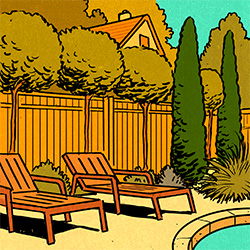Out of Sight: Privacy Fence Ideas
From sunny afternoons by the pool to dinners on the patio, there are plenty of moments you’ll want to shield yourself from prying eyes. Here are three ways to increase your private time.
Having the healthiest patch of turf with a slick outdoor kitchen or a pool with crystal blue water won’t help you and your guests relax if you lack privacy. As much as you like your neighbors, do you really want to lock eyes with Ron while he’s watering his lawn and you’re passing the ketchup? It might not be top of mind now when you’re sharpening your tools or prepping your grass for the growing season, but privacy is a yard feature that should not be overlooked.
Back in 1914, long before camera phones and social media, Robert Frost wrote, “Good fences make good neighbors.” Without a privacy plan, you can feel exposed and uncomfortable in your own backyard.
Shop This Story
Z530M ZTrak™ Mower with 48-in. Deck
SHOP NOWPremium Black Stripe Lawn Chair
SHOP NOWPlaid Fleece Blanket with Waterproof Backing
SHOP NOWSmokey Mountain Cooker Smoker
SHOP NOWCharcoal Grill (HR-CGS225)
SHOP NOWLife in Motion XL Cargo Box
SHOP NOWCooler Carrying Picnic Bag
SHOP NOWFire Pit
SHOP NOWBut having privacy is more than just creating a visual buffer that prevents unwanted eyes from crashing your party. It’s also about enhancing your views by editing out what you don’t want to see, like a neighbor with a penchant for morning Zumba, short shorts, or sunbathing through a thicket of back hair. A barrier of plants, fencing, or some combo of the two is the most common way to enhance privacy for a range of budgets and DIY aptitudes. If you have the budget and need privacy ASAP, a fence will block most views at the ground level.
But if you don’t mind waiting a few years for a wall of plants to create a green screen, using younger versions is a less expensive option. Before you grab a shovel, though, you’ll need to know where your property line is and stay within that to ensure neither a new fence nor the mature width of a tree encroaches on your neighbors. Many towns cap residential privacy fences to 6 feet high, but there is usually no restriction on the size of trees or shrubs, which can, over time, offer the greatest level of privacy and aesthetics. Here’s what you need to know about adding a little more seclusion to your yard.
The Plant Fence

If you think a fence is the only route to privacy, you’ve never tried to see through a 4-foot-thick wall of evergreens. A wide range of evergreen and deciduous trees and shrubs can provide all the privacy you need while softening the yard’s boundaries with a natural look. (Of course, if you go with a deciduous tree, you’ll want to factor in the falling winter leaves against your privacy needs.) Plant material requires a little more research upfront—to know your yard’s growing zone, light, and soil conditions along with their distance from a water source—but once established, trees and shrubs might only require occasional pruning for shaping or raking leaves.
Nearly any privacy plant will grow taller than a physical fence but will require more width than a wood or PVC panel, so it might not be the best solution if space is tight. You can spend thousands on a handful of mature trees and shrubs for instant privacy, or purchase smaller, less expensive versions and wait a few years for the investment to develop into a verdant wall.
Popular, hard-to-kill evergreens include “Emerald Green” (“Smaragd”) or “Green Giant” arborvitae, several varieties of laurel and Leyland cypress, “Hicksii” yew, and American holly. Flowering options include cherry, pear, and magnolia trees, which provide season screening with flowers that emerge each spring.
Before you start picking plants, it’s important to understand their mature width and to use that measurement while spacing. Ignore it and you might be planting expensive trees and shrubs too close together, which results in crowding and can stress a plant’s health by making it compete for nutrients.
Best for: DIYers and those on a budget who are willing to wait a few years for plants to mature. When the budget allows for mature stock, expect to work with a landscaper or nursery to install them.
Aesthetics: Great! A living wall is far more appealing than a wall of wood or PVC and often does a better job of blending into the natural environment of a yard.
Time and money: From about $5.70 per linear foot for a 1-gallon size “Emerald Green” arborvitae (that will reach 12 to 15 feet tall in 15 years) to about $233 per foot for a 12-foot version of the same tree.
Materials: Evergreen, deciduous, and flowering trees and shrubs.
Privacy: Depends on the maturity of plants but can range from a screen to a solid wall of green.
Shop This Story
Z530M ZTrak™ Mower with 48-in. Deck
SHOP NOWPremium Black Stripe Lawn Chair
SHOP NOWPlaid Fleece Blanket with Waterproof Backing
SHOP NOWSmokey Mountain Cooker Smoker
SHOP NOWCharcoal Grill (HR-CGS225)
SHOP NOWLife in Motion XL Cargo Box
SHOP NOWCooler Carrying Picnic Bag
SHOP NOWFire Pit
SHOP NOWThe Wood Fence or PVC Fence

If your yard needs privacy in a hurry, it’s hard to beat a view-blocking 6-by-8-foot swath of fence. Unlike the 4-foot-tall pickets spaced a few inches apart in the front yard, a privacy fence is often a complete wall that separates you from the neighbors. Privacy fence panels come in three major materials—from classic dog-eared, pressure-treated pine, and composite versions that mimic the texture of wood decking to gleaming white PVC. Wood is the least expensive option upfront but often requires staining or painting to keep weathering at bay. Pricier PVC and composites are virtually hands-off, aside from occasional power washing.
While a solid panel is popular, most materials offer semiprivate options topped with an airy lattice or where boards within the panel are spaced an inch or so apart, allowing for light, breeze, and limited views. An ambitious DIYer should be able to install a few panels around a patio, but putting up a whole yard’s worth of fencing—especially when a gate or hills are involved—should be left to a contractor.
Depending on your climate, you may also need to dig a hole for sinking posts in concrete. While a contractor will know to call 811 (a service that will visit your house and check the location for any buried water, gas, or phone lines running through your yard before installation), homeowners should do the same for any DIY job.
Best for: Homeowners who have a bigger budget and a need for immediate privacy around the yard or patio.
Aesthetics: Varies from a solid wall of material to a half-open design but generally not as natural looking as plants. Some have a less desirable face with posts and rails that you might want to keep toward your yard.
Time and money: Starting at about $9.40 per foot for wood, $14.50 for PVC, and $40.50 for composite fence panels. The average cost to install a fence adds about $3,000 to the project.
Materials: Wood, PVC, or composite.
Privacy: Exceptional for privacy up to 6 feet, covering most grade-level needs. However, a fence might not be tall enough to prevent views from a neighbor’s second story.
The Combo Solution

Combining plants with a fence is often the most aesthetically pleasing option, which is important for barriers that face the street or those nearest to the house, like around a patio or deck. The benefit is having a physical barrier, which can help keep pets in or out while also softening hard lines with plant foliage.
The technique might rely on a fence with a more open design like a metal picket fence combined with an evergreen shrub that fills the voids between the vertical members. Or a layering design can be used in which a short fence rests in front of taller trees or shrubs, or when ivy or flowering vines use a fence to climb.
Growing privacy trees and shrubs in planters enables you to change the design on the fly. A handful of large arborvitae in big planters might be all the privacy you need for an intimate party, and you can move them around the patio or the pool as your needs change.
Best for: Side yards that require the security of a fence or for a patio or deck.
Aesthetics: High! A combination of materials is an elegant way to make a fence part of the landscape’s overall design.
Time and money: While the price varies depending on the material of the fence as well as the type and age of the plants, a basic design starts at about $16 per foot for immature arborvitae and a simple wood fence, and it goes to $280 per foot for larger trees and more expensive composite panels.
Materials: Typically evergreen plants and wood, PVC, metal, or composite fence panels.
Privacy: Medium to high depending on the plants and fence panel used.


